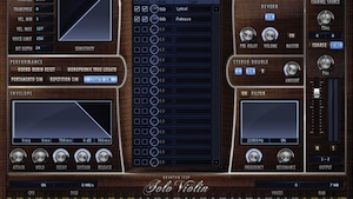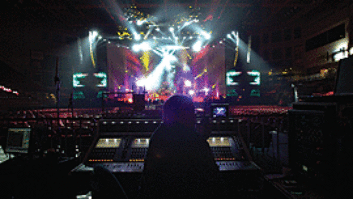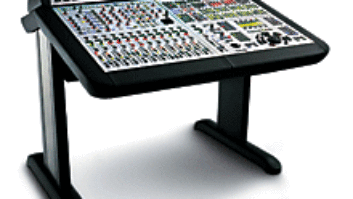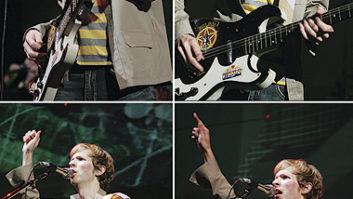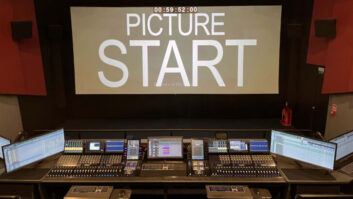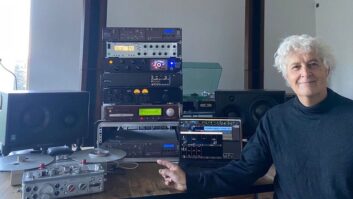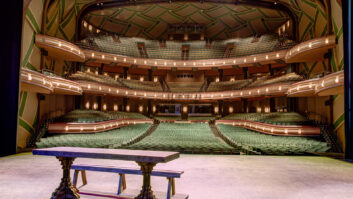ENGINEERS ARE CREATURES OF HABIT. They like to use certain consoles, certain effects, certain mics, certain techniques. Now throw in the urgency inherent in a live environment, and you can see why many sound reinforcement mixers rely on their tried-and-true gear. They know it works.
But in today’s lean recording business economy, the sound reinforcement world is also finding ways to maximize the efficiency of touring in a downscaled environment. When management says cut back, engineers must make do with smaller rigs, easing equipment-rental costs, decreasing the trucking/gas budget and, perhaps most importantly, allowing more tickets to be sold. Think about it: If you can free up even 40 seats at one gig, with profits of, say, $20 per ticket, that’s $800 a night. Multiply that by five to six shows a week, touring for almost a full year, and you’ve got quite a bit of change.
Luckily, slimming down the rig is not all sacrifice. There are plenty of benefits to working with compact digital consoles, which offer a smaller footprint, onboard functionality that’s equivalent to racks of gear and a streamlined user interface. Mix chats with a handful of front-of-house engineers who recently took the digital challenge.
Brad Madix: “I think we can assume at this point that digital audio will continue to improve.”
THE PLAYERS AND THEIR RIGS
Mark Newman has been an audio engineer for the past 20 years, having toured with Lucinda Williams, Neil Finn and The Wallflowers, to name a few artists. He is currently on tour with Blondie after mixing FOH with the Black Crowes for eight months last year. During the Crowes’ tour, Newman, who had previously mixed on a Midas XL4, scaled down his setup by switching to a Yamaha PM5D with little outboard gear (TC Electronic D2, BSS 901 Mark II, Empirical Labs Distressor). “The timing was right for me to spend a day at Delicate Productions [Camarillo, Calif.], getting an orientation on the digital console,” Newman says. “I wanted to try a digital desk.”
The last time Mix caught up with Brian Boyt [“Soundcheck,” July 2004], he was mixing FOH for Maroon 5. When we spoke with him a few months ago, Maroon 5 was in the middle of recording their next release and were planning a world tour, carrying consoles almost 100 percent of the time; previously, they had only carried a mic package. Boyt hasn’t made the decision to go digital yet, “but I will probably have an A/B shootout with the analog stuff before we head out again,” he says.
The Cure’s FOH engineer, Craig Overbay, first used a digital console (a Yamaha PM1D) during the band’s 2004 tour. The decision to go digital resulted from a conversation that Overbay had with Cure monitor engineer Ian Beveridge, who was already taking out a PM1D. Overbay says he opted to “take a jump into the deep end of the pool.” He is also carrying one rack of outboard gear.
Evanescence FOH engineer Eddie Mapp is now touring with P.O.D., who are out in support of Staind. He is carrying a Yamaha PM5D. (He had a Midas XL4 with Evanescence.) He is using pretty much everything onboard except for two Crane Song pieces: STC8 on bass and Trakker on lead vocal. “Other than that,” he says, “I’m trying to not go through any more conversion than I have to.”
Brian Boyt: “I had the option to go digital, and it was a huge benefit because you could put the support acts on there.”
Photo: Steve Jennings
Brad Madix spent the last year touring with Queensryche and is now working with Fort Minor, a rap side project of Mike Shinoda (Linkin Park); they’ll be out on tour at the end of this month. All he is using is a Yamaha PM5D. “I’m finding the more I get into [digital consoles],” he says, “the more I can wring out of them. I had kind of weaned myself off of one little piece of gear after another.”
Robert Scovill was most recently out with Tom Petty, carrying quite a formidable rig: a 56-input Paragon PII console, five 22-space effects racks (system crossovers, computers, dynamics, EQ, effects and instrument processors) and two 14-space racks housing a 64-input Pro Tools|MIXPlus recording system. However, he has moved over to a Digidesign VENUE; he served as a development consultant for Digidesign. Regarding this switch, “I have not only replaced all of the gear with a mixing platform,” Scovill says, “but I have more than doubled my inputs potential and effects processing capabilities.”
TAKING THE DIGITAL LEAP
Many engineers are finding that digital boards offer a number of cost-cutting solutions on tour. As Mapp points out, taking out a digital board reduces shipping space. “One thing that I’m seeing a lot of on mid-sized tours is management pushing for digital consoles,” he says. “They’re trying to sell more seats and save costs on shipping and trucks. When you can put four acts on one console [in a festival-type situation], as opposed to a minimum of two consoles, it is more cost-effective. It’s less processing to carry and allows more flexibility for opening acts.”
Because Maroon 5 will be carrying boards for their upcoming tour, Boyt had to come up with a smaller package that could be easily shipped around the world. “What I normally use is a Heritage 3000 and bunch of outboard gear, and it turns out to be three or four racks and a desk,” he says. “Now, I am a huge fan of what I’ve got going on right [Drawmer gates, BSS and dbx comps, Manley VoxBox, Yamaha SPX-990s, Eventide H3000, TC Electronic delays], so changing it doesn’t really make much sense to me. But for economical reasons and for sake of consistency, I think that the best bet is to use a digital console and I can carry that and one rack.”
Overbay’s decision to go digital was mainly due to the technology: “I thought, ‘Well, [The Cure] is going to be doing a tour in Europe and then a tour in the U.S. and, in theory, I don’t have to take out the same console [a Yamaha PM1D].’ I can just save my show and move it from one place to the next and it should come up the same. At least that’s the way it says in the manual!
“When Weezer did a club tour run,” Overbay continues, “I specifically took out a Yamaha PM5D, and that worked out great, both for myself and the monitor engineer.” Right after Weezer finished their club tour, they hooked up with the Foo Fighters on a double-billed tour, in which both bands and the opening act were sharing one console — a DiGiCo D5 — a decision made by the engineers and not management. “And that was great,” Overbay remembers. “I mean, it is a digital console; isn’t that kind of the purpose of it? Everybody could just go up, load your show and away you go. And we still had a couple of racks of outboard, but not much. And if you think of a tour like that — it was an arena tour — where there would normally be two XL4s and then maybe a PM3000 for the opening act, you really start to see the benefits.”
UPS AND DOWNS OF ALL-IN-ONE
For engineers making the jump to digital, how has the new technology affected their mixing approach? The biggest issue in switching to a digital console seems simply to be a matter of wrapping their heads around using a computer screen rather than having a rack of blinking lights and knobs. However, for engineers used to the immediate access of analog, a few logistical compromises are necessary.
“I lay out the inputs differently than how I normally would on an analog desk,” says Overbay, “just so they make sense to me. The PM5D is 24 in, and then you hit a button and it flips to the next 24, so a lot of times, you’ll put the 24 faders that you will use the most on the first layer and then the secondary stuff on the second layer.”
Eddie Mapp: “When you can put four acts on one console, it is more cost-effective.”
Photo: Steve Jennings
There is also an intuitive change to how they approach their setup. The compactness of these digital boards places all functions within an arm’s reach, offering an incredible amount of flexibility in setting up a mix. According to Madix, “One thing I really like is that everything is right in front of me [on a digital board]. I realized I never had to turn or lean over and reach down and fuss with the knobs. I can always be sitting in the same position, more or less, and still have my head in the mix, as opposed to stooping down and looking at a whole other panel and getting a handle on where all the knobs are and find out what I need to adjust. Just being able to sit there and bring up whatever dynamic or EQ or effect or whatever as opposed to taking your head out of that space.”
Scovill agrees: “The most noticeable difference for me was having all the effects processing and dynamics processing literally at my fingertips. It made for some really great workflow. I never had to turn around or leave the listening field to operate a piece of equipment. It could always reside in my line of vision, so I rarely had to take my eyes off the stage. Also, the reliability factor was a big one. There was no chance of any knob getting accidentally tweaked and laying as a landmine for you once the show began.”
However, some engineers cite the lack of effect options as a downside to replacing their racks of outboard.
“I’m trying to get the same dynamics, effects, compression out of what is resident in the console,” Madix says. “There isn’t anything on that desk that is like a Distressor simulator. But you start thinking, ‘When I use a Distressor, what is it that I’m doing to the sound exactly?’ as opposed to wanging the knobs out until it sounds right. I’m thinking about what I’m doing in a more quantitative way. I find it’s easier to not get bogged down in all these workings of the equipment because it’s right there in front of you; it’s really easy to get in and out of editing something on the fly, as opposed to running around and trying to get three pieces of gear chained together to sound a certain way.”
But as technology advances, digital boards are sounding better and better (improved algorithms, expanded effects options). Mapp sees this as a motivator for engineers to take the digital route. “Processing is getting so good that you don’t want to go through any extra converters. The Digidesign VENUE I think is amazing because you have access to any outboard gear you wish through plug-ins. Why would you want to go somewhere else outside the console? I don’t think analog consoles are ever going to go away. [But] once digital gets to the point where it becomes pretty seamless, I think we’ll see a greater move toward all-digital consoles.”
Robert Scovill: “[With a digital console], I never had to leave the listening field to operate the equipment.”
At the end of the day, Newman’s main concern hasn’t changed. “A lot of the ‘pluses’ to downsizing gear by going digital don’t concern me,” he says. “I’m not worried about how many seat kills are needed to accommodate my equipment or how much space in the truck is needed The size of the equipment doesn’t affect my mixing, but the way the console operates and sounds does. My head seemed to be buried in the computer screen too much on a digital board. If it doesn’t sound good or suit my needs as an engineer, I don’t want to use it.”
LOOKING AT A DIGITAL FUTURE
Digital consoles are becoming a fact of life in the SR world, whether it’s an effect of “downsizing” a FOH rig, a result of the sound company stocking up on the latest version of each digital board or it’s just a matter of engineers becoming more comfortable behind a computer screen. If you’re not comfortable going digital, you may be out of a job.
“As an example,” Boyt says, “I went out and worked for Rat Sound when they did the Inland Invasion tour, and they were completely out of gear. So what they did was they got four PM5Ds and that was a lot cheaper than going out and getting outboard effects and consoles and patches. And it worked out great. I had the option to go digital, and it was a huge benefit because you could put the support acts on there.”
Overbay agrees: “I would say without question [moving to a digital console] is a trend. Obviously, if a person wanted to, they could bring in a boutique analog sidecar and bus it into a digital desk. All of the audio is converted to digital eventually because it’s going through digital crossovers. The idea is to convert it to digital only once. I still want a Manley VoxBox for my lead vocal and a Drawmer 1960 for my acoustic guitars. I will then use all the onboard signal processing for the rest of my inputs. In the case of the analog outboard gear, it is a comfort issue as much as anything.”
“I think that we can assume at this point that digital audio will continue to improve,” says Madix. “It has for the past 20 years. And I would say the same thing about reliability: It’s fairly reliable now. There are a handful of stories floating out there about it all going wrong, but really, it can all go wrong on an analog desk, too. I think that somehow in your head when something goes wrong on an analog console, it’s a little easier to grasp than on a digital console; it seems that there is a ghost in the machine as opposed to, ‘Well, the switch is broken.’”
Craig Overbay: “I can just save my show and move it from one place to the next and it should come up the same. At least that’s the way it says in the manual!”
Photo: Steve Jennings
You can almost see the day when engineers will no longer be carrying much equipment at all, except perhaps a favorite mic or EQ; instead, they will save their presets on a card, as digital consoles can be ordered from a local sound company or the board will be installed at the venue.
“It is very possible,” Overbay concurs, “as the music industry retools itself from artists that used to sell multiple millions of records to that same artist selling a million or half-million records to promoters trying to pay the high guarantees and to management companies trying to trim the fat, some day, we will see installed in all the sheds that we tour in every summer a generic house sound and lighting rig. You do a few days of rehearsal at the first venue with your backline and ‘set’ and off you go. Package tours will be put together just like they are now. This may be the way of the future, mainly in purpose-built venues like sheds. Of course, there are many issues technically and artistically to overcome, not the least of which will be consistent sound quality.”
“Of course, the problem with that right now,” says Madix, “is that there are five different versions and I don’t have a card for each of them. I wouldn’t bet that one version is going to win out over the others at this point. It’s important to keep in mind that even though the desk is digital, it still has to change the audio into a digital format. And they do it in different ways; some of them are more pleasing to certain people than others.
“Now, we’ve done it lately where 60 or 70 percent of the shows that we do, we can have somebody bring [a digital console] in from somewhere and we walk in and pop in a card. On that note, I learned the other night that there are older versions of the system software floating around that don’t like my card and I learned the new world of on-the-fly firmware upgrade. But it can be done, and we did it and it worked. And wouldn’t it be nice to not have to set up your desk every day?”
Sarah Benzuly is Mix’s managing editor.
